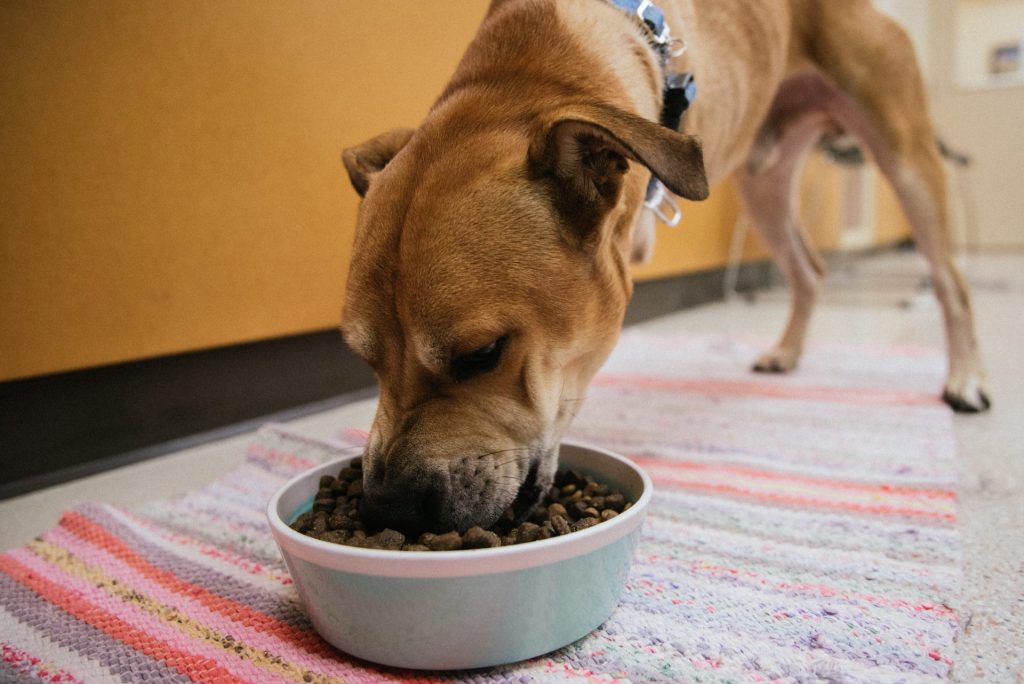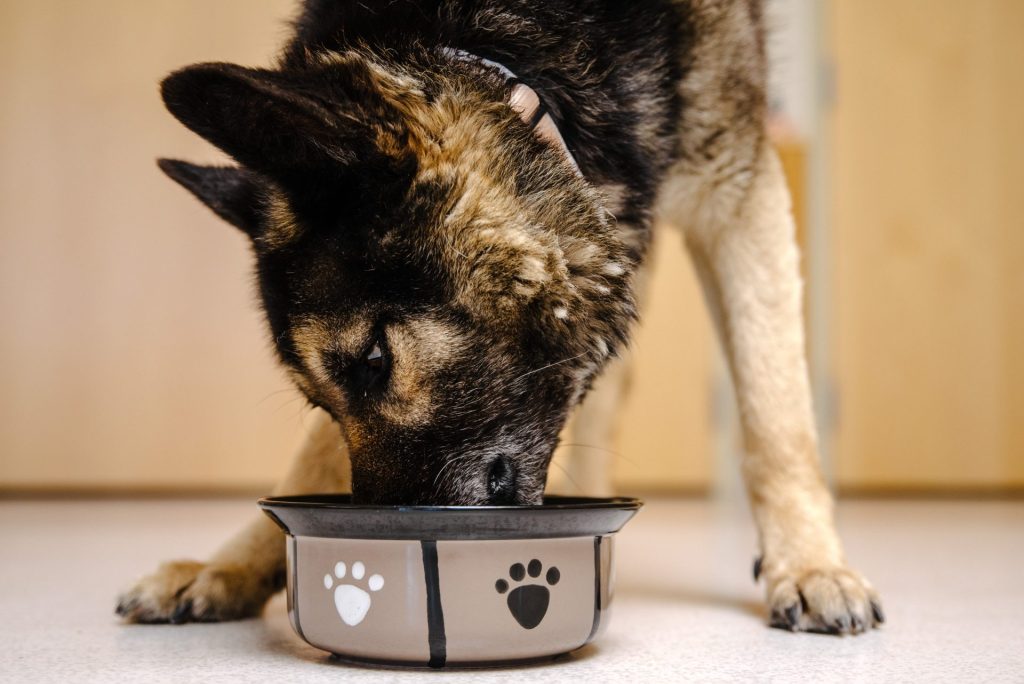The quality of our pet’s food can play a major role in their overall health and longevity. In a crowded marketplace, however, it can be difficult to discern what type of diet is the best fit. Dr. Franci Forman, OHS’ Community Veterinary Hospital Medical Director, suggests to first look for the nutritional adequacy statement from the Association of American Feed Control Officials, or AAFCO. Typically found on the back or the side of the pet food bag in small print, this statement is a good indicator that the food inside meets the nutritional standard needed for animals.
Important Note: High-quality pet food doesn’t have to mean more expensive– there are many affordable foods that meet the AAFCO nutritional standard!
We recommend working with your veterinarian when considering specific diets for your pets, but to guide you in your process, we have broken down some of the ins and outs of common pet food diets.
Diet Types
Grain-Free
A popular diet type marketed heavily in recent years, grain-free foods can appear enticing. However, Dr. Forman does not recommend a grain-free diet unless specifically directed by your veterinarian.
The issue? Grains are an essential nutrient. Many grain-free foods remove the grain but do not replace this missing nutrient. While grain-free diets have been marketed as an option for pets with food allergies, Dr. Forman notes that pet food allergies are most typically tied to the protein source, not the grains.
“Most pets do not have grain allergies. It’s actually really rare. Grains can help provide really valuable sources for fiber, energy, and nutrients,” says Dr. Forman.

In fact, there’s is an ongoing FDA investigation into the link between certain grain-free diets and heart disease in dogs. While the exact link is still being determined, the data collected so far indicates that grain-free diets may be linked with some forms of heart disease. If you are feeding a grain-free diet, ensure your pet food has the AAFCO nutritional statement, so you know that the nutrients from the grain have been replaced by another ingredient.
If you suspect your pet has food allergies or other chronic skin issues, talk to your veterinarian about their diet before making changes to rule out any other underlying issues.
Raw/Dehydrated
Another diet touted by pet owners eager to give their pets a food that feels natural and close to what their animal-ancestors may have eaten is the raw food diet, which has taken center stage in recent years.
Dr. Forman, however, is wary. “Raw pet food is more likely than other types of pet food to carry bacteria, including things like salmonella and listeria. The FDA has issued warnings about the public health risks associated with raw food diets.”
The same is true for freeze-dried raw diets—which sometimes appear safer because they are shelf-stable. However, it was a raw, freeze-dried treat that was linked to a recent H5N1, bird flu outbreak in pets here in the Pacific Northwest.
Fresh Foods and Homemade Diets
Fresh foods are not the same as raw diets, as the ingredients in these food sources are fully cooked. There has been a significant expansion of these options in the past few years, and Dr. Forman notes that many of the companies who manufacture fresh foods do work with veterinary teams in their development and research to ensure a balanced diet. As with any pet food, Dr. Forman recommends looking for the options with the AAFCO statement.
Homemade (fully cooked) foods are not going to have the AAFCO statements, so there is more potential for nutritional imbalance leading to inadequate levels of essential nutrients like calcium, phosphorus, vitamin D. However, there are veterinarians who can evaluate the nutritional needs of your pet and recommend supplements and additives that can be incorporated into your homecooked meal plan to ensure your pets diet meets their nutritional needs. “If you’re really adamant about wanting to make your pets food at home, discuss things with your vet to come up with a plan,” says Dr. Forman.

Specialty Diets
Specialty diets can significantly slow down disease processes for conditions like kidney disease, diabetes, and thyroid disorders. Luckily, there is a lot of research to backup these diet types, so the formulations for specific illnesses tend to work well.
“Urinary diets are used with many of our patients that have urinary stones or chronic urinary diseases. The right diet can impact the health of our pets—not only in preventing diseases but also in managing chronic illnesses,”
explains Dr. Forman.
For specialty diets like these, you will need to work directly with your veterinarian to rule out any other root causes of symptoms your pet may be experiencing.
Life Stage
Ensuring your pet is on the right type of food for their life stage is another important piece of the puzzle. Puppy and senior diets are both formulated specifically to respond to a pet’s needs at that particular life stage. “Senior diets tend to have increased fatty acids and omegas to help with joint support and arthritic changes. These foods are also a little bit lower in calories because, unlike the three-year-old dog or cat who’s bouncing off the walls, senior pets don’t expend as much energy and don’t need as many calories,” says Dr Forman. Below is a general guide for life stage timeframes to reference when considering diet transitions.
Life Stage Diet Guide
| Age | Life Stage Diet |
| 0 – 1 | Puppy/Kitten |
| 1-7 | Adult |
| 7+ | Senior |
| Nursing Mothers | Puppy Food |
Weight Management
The two main things that affect weight are calorie intake and exercise. This is why ensuring your pet is getting the right nutrition for their life stage is important. Pets who are overweight are more at risk for developing serious health problems which may reduce their lifespan.
If you are curious or concerned about your pet’s weight, talking with your veterinarian to get a body condition score and understanding their ideal weight is a great starting point.
“As they start slowing down, a 14-year-old lab doesn’t need the same food as the two-year-old lab. It is important to make changes with the different life stages as well as calories and activity levels.”
says Dr. Forman.
Treats and People-Food
The quantity and type of treats you should give your pet depends on their life stage. “Pets in a heavy training stage, where you’re doing a lot of work with them are going to need more treats to encourage their learning. A newly adopted cat to a home is also going to need more treats,” says Dr. Forman. While rewarding your pet is okay, she recommends increasing exercise opportunities when pets are in a high-rewards phase to ensure they are burning excess calories.
People Food
It’s important to remember our pets can’t have everything that we can have. There are some ingredients that are toxic to our pets, so always look up an item before giving it to your pet for the first time. Fresh treats are fine, but always in moderation. “A small piece of cheese for a dog is like one of us eating a brick of cheese,” reminds Dr. Forman—so pay the cheese tax, mindfully.
How to Make the Switch
When you are ready to make a pet food switch, whether you are wanting a higher-quality food or making a life stage change, it’s important to make the change slowly over the course of one to two weeks. Dr. Forman recommends starting with 75% of the current food and 25% of the new food.
If your pet is not showing any signs of GI distress, such as increased vomiting or diarrhea, then you can up your ratios to 50/50 for about three to five days. If after three to five days your pet is still showing no signs of upset, then you can up the ratio to 25% of the old food and 75% of the new food.
While some pets can handle a change quicker than others, it can easily take up to two weeks or more depending on how your pet is reacting to the change. “Any time we’re changing something of their baseline, we try to do it slowly,” says Dr. Forman.
At our Community Veterinary Hospital, we are passionate about keeping your pets happy, active, and healthy! Early disease detection, nutrition and weight management, vaccination, and parasite control can help keep pets living their best lives.




